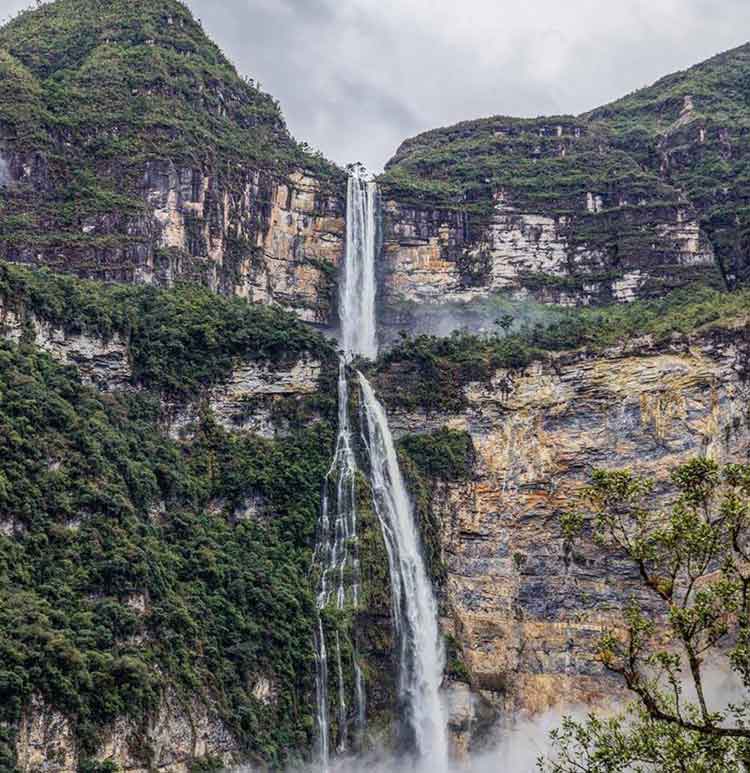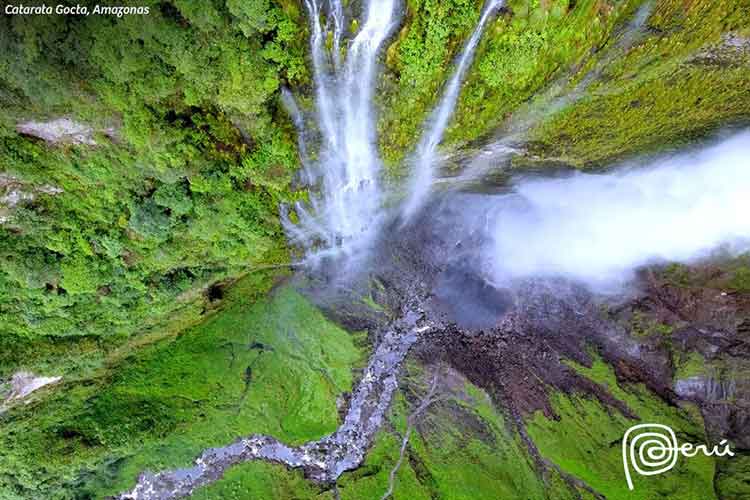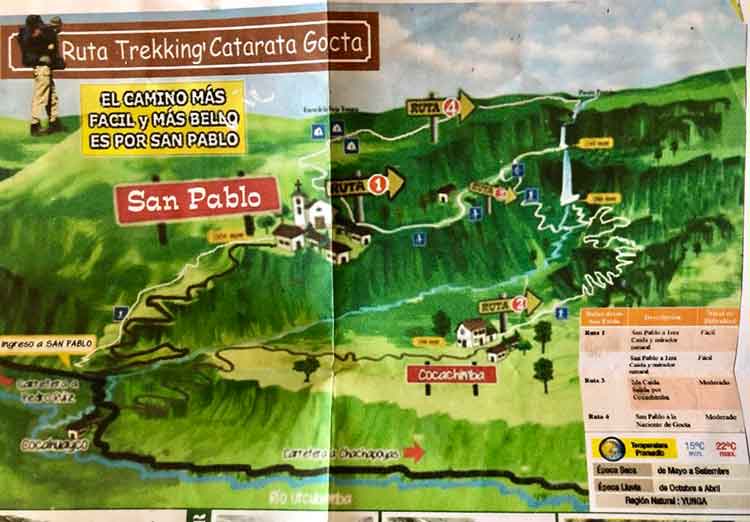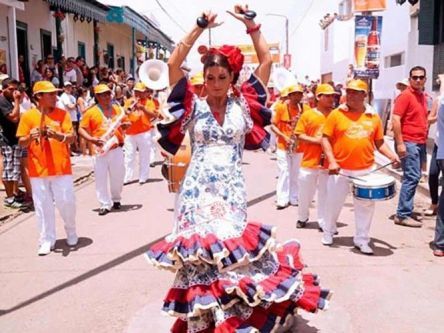Peru is full of natural wonders that are lesser known and / or located off the beaten path and therefore missed by most visitors when planning their trip. One of these are the Gocta Waterfalls located in the Chachapoyas province in the Amazonas region of northern Peru.
Considered one of the major waterfalls in the world and South America and most probably the second tallest waterfall in Peru (after the Tres Hermanas – Three Sisters – Falls in the Ayacucho province) , the Gocta Falls is a tall, moderate to high volume waterfall which drops a total of 771 m (2,531 feet) in two leaps. The upper drop falls about 230 m (750 feet) in a purely vertical fall, the lower drop 540 m (1770 feet) in a nearly vertical fall into a massive pool.
As there is no standard way to measure and uniformly classify waterfalls, depending on the source the Gocta Falls rank anywhere between the 3rd highest waterfall and the 17th tallest waterfall in the world in the World Waterfall Database. On the list of the world’s highest single drop waterfalls the lower drop of Gocta is placed on position 5.

But regardless its rank, the scenic hike through the Amazonian cloud forest with all its sounds, smells and stunning flora and fauna, then the first small sounds of the falling water which increases in volume as you get closer as does your anticipation and finally the first sight of the impressive and stunning cascade surely makes a visit of the Gocta Falls a unique and outstanding experience.
Discovery of Gocta
For ages the Gocta Falls have been well known to locals. But as they were shrouded in legends – varying from a giant snake protecting a golden bowl in the pool of the falls to a mermaid enchanting the men of the nearby village and taking them into the depths of the falls - locals avoided the impressive waterfall and Gocta remained one of the best kept secrets of Peru.
Only in 2002 the German explorer and mummy expert Stefan Ziemendorff officially discovered the Gocta Falls by “accident” while being in search of sarcophagi of the Chachapoyas culture in the Peruvian Amazonas region. Being convinced that he discovered one of the great falls of the world, he persuaded the Peruvian government to survey the falls and exactly measure their height. The results were finally published in 2006 putting the Gocta Falls among the tallest waterfalls of the world and making them next to Kuelap and The Sarcophagi of Karajia one of the main tourist attractions of the area.

How to get to the Gocta Falls
If you aren’t part of a tour or booked yourself into accommodations close by, the best place to start your trip to the Gocta Falls is Chachapoyas, the capital of the Amazonas region in northern Peru. From there you either can make your own way or use one of the tour agencies (easy to spot around Chachapoyas main square) which offer half-day trips including round trip transportation and entrance fee for around S/ 60 (going on horseback for the difficult parts of the hike or for the way back will increase the bill significantly).
There are two different starting points to hike to the Gocta Falls.
Starting point Cocachimba
About an hour’s drive (45 km / 28 miles) from Chachapoyas is the small villages of Cocachimba where booked tours begin the hike, but which you can reach with private or public transportation as well if you want to make the trip on your own.
From there it’s a 2 to 3 hours hike (about 5 km / 3 miles one way) through the amazing cloud forest to the foot of the falls. The trail is well maintained and easy to follow. After the first 2 km where hikers have to conquer some steep inclines and downhill sections, it’s an easy hike to the bottom of the Gocta Falls.
A good option even for less experienced hikers.

Starting point San Pablo
If you plan to go independently or with a private guide, starting at San Pablo (as well about an hour’s drive from Chachapoyas) actually gives you more options. Once you reach the little village either by private or public transportation, you can choose two different trails:
- The first trail leads you on a moderate to difficult hike to the top of the Gocta Falls. Unfortunately, there is no connection from the top tier to the second tier or the pool, so hikers have to go back to San Pablo and choose the second trail to get there.
- The second trail from San Pablo brings you in about 2 to 3 hours (5 km / 3 miles one way) on a clearly marked and well-maintained path to the middle section of the falls. It’s an easy to moderate hike. From there hikers can get back to San Pablo on the same way or after about 1 km (0.6 miles) turn into a slightly hidden path which leads to the bottom of the waterfall. Expect about 7 km (4.5 miles) of steep downhill hiking before meeting the trail from Cocachimba.
Some advice: Hikers are advised to finish their hike in the early afternoon if they haven’t secured reliable transportation back to their accommodation or Chachapoyas in advance as most services close around 03.00 pm and 04.00 pm. So if you plan to hike to the top, middle and bottom section or just the middle and bottom section of the Gocta Falls start your hike (super) early to make it back on time. And take enough water and snacks with you as there aren't any options to buy anything along the trails.
Where to stay to hike to the Gocta Falls
Probably the hotel with the most stunning view of the Gocta Falls is the Gocta Lodge in Cocachimba. All their 8 rooms and 2 suites as well as the garden and pool face the waterfall.

Another great option is the cloud forest eco-lodge Gocta Natura Cabins located near Cocachimba. Gocta Natura Cabins offer eco-friendly boutique accommodation as part of a wider environmental initiative in the Gocta Nature Reserve. Committed to actively contributing to the recovery of the cloud forest and biodiversity, the initiative which is partly funded by the cabins, also supports local community development projects.








































